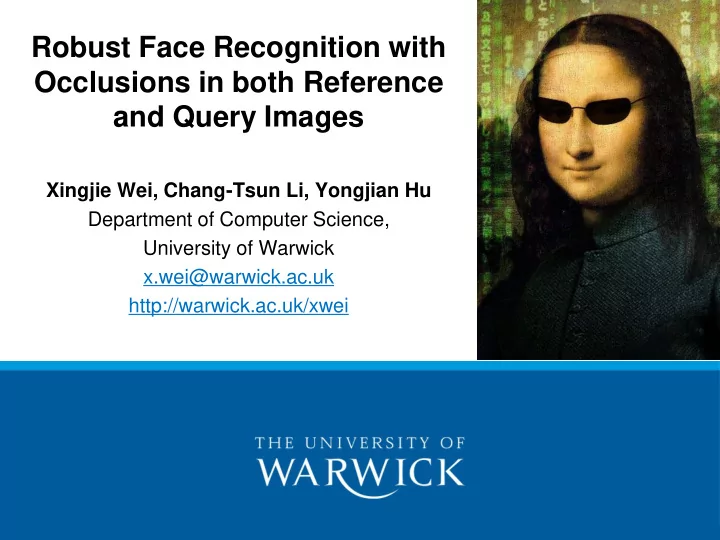

Robust Face Recognition with Occlusions in both Reference and Query Images Xingjie Wei, Chang-Tsun Li, Yongjian Hu Department of Computer Science, University of Warwick x.wei@warwick.ac.uk http://warwick.ac.uk/xwei
Outline • Face recognition with occlusions • Current methods • Three occlusion cases • Our methods • Experimental results 2
Face recognition with occlusions • Intra-class variations > inter-class variations • Causes imprecise registration of faces poor recognition performance ! 3
Face recognition with occlusions • Why is it so difficult? • No prior knowledge of occlusion • location,size,shape,texture -- unpredictable! 4
Current methods Reconstruction based methods [Wright et al. PAMI09, Yang et al. ECCV’10, Zhang et al. ICCV’11] – An occluded probe image is represented as a linearly combination of unoccluded gallery images – The probe image is assigned to the class with the minimal reconstruction error Assume the gallery/training images are clean 5
Three occlusion cases 6
Current methods Very limited work considers the existence of occlusions in both gallery and probe sets • [Jia et al. FG’08,CVPR’09] – Proposed a reconstruction based method in, as well as an improved SVM Depend on an occlusion mask trained through the use of skin colour • [Chen et al. CVPR’12] – Uses the low-rank matrix recovery to remove the occlusions 7 Requires faces to be well registered in advance
Our method • Dynamic Image-to-Class Warping – An image a patch sequence – Matching the Image-to-Class distance No occlusion detection No training phase 8
Our method • Face representation – Natural order: forehead, eyes, nose and mouth to chin does not change despite occlusion or imprecise registration 9
Our method • Image-to-Class distance – from a probe sequence to all the gallery sequences of an enrolled class – each patch in the probe sequence can be matched to a patch from different gallery sequences 10
Our method (1,1,1) Warping path: : (4,3,2) M N 11
Our method Warping path: : • Constraints: – Boundary – Continuity – Monotonicity – Window constraint: Maintains the order of facial features 12
Our method P • Local cost G • Optimal overall cost the optimal 13
Our method • Why does it work? – Tries every possible warping path and select the one with minimal overall cost – Exploits the information from different gallery images and reduce the effect of occlusions 14
Our method Dynamic Programming (DP) 15
Experiments • The FRGC database – 44,832 images with different illuminations and expressions, 100 subjects selected • The AR database – >4000 images with real disguise, 100 subjects selected • Realistic images – >2000 frontal view faces of strangers on the streets, 80 subjects selected 16
Synthetic occlusions • Uvs.O Block size : 0%~50% – Gallery of the image – Probe • Ovs.U Block location : – Gallery random and unknown – Probe to the algorithm • Ovs.O – Gallery – Probe 17
Synthetic occlusions Uvs.O Ovs.U 18 Ovs.O
Real disguises • Uvs.O – Gallery – Probe • Ovs.U – Gallery – Probe • Ovs.O 1. Gallery Probe 2. Gallery Probe 19
Real disguises 20
R ealistic images 21
Thank you • Questions ? • Xingjie Wei • x.wei@warwick.ac.uk • http://warwick.ac.uk/xwei • Department of Computer Science, University of Warwick 22
Recommend
More recommend